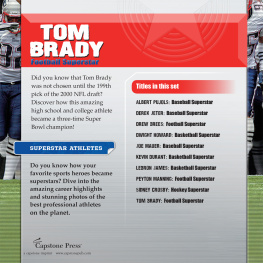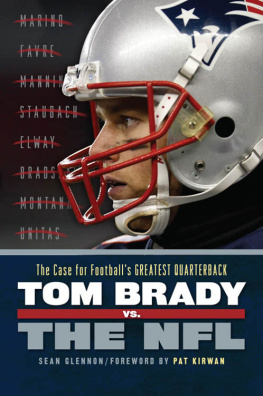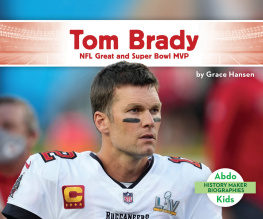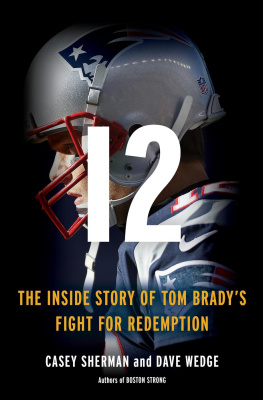The author and publisher have provided this e-book to you for your personal use only. You may not make this e-book publicly available in any way. Copyright infringement is against the law. If you believe the copy of this e-book you are reading infringes on the authors copyright, please notify the publisher at: us.macmillanusa.com/piracy.
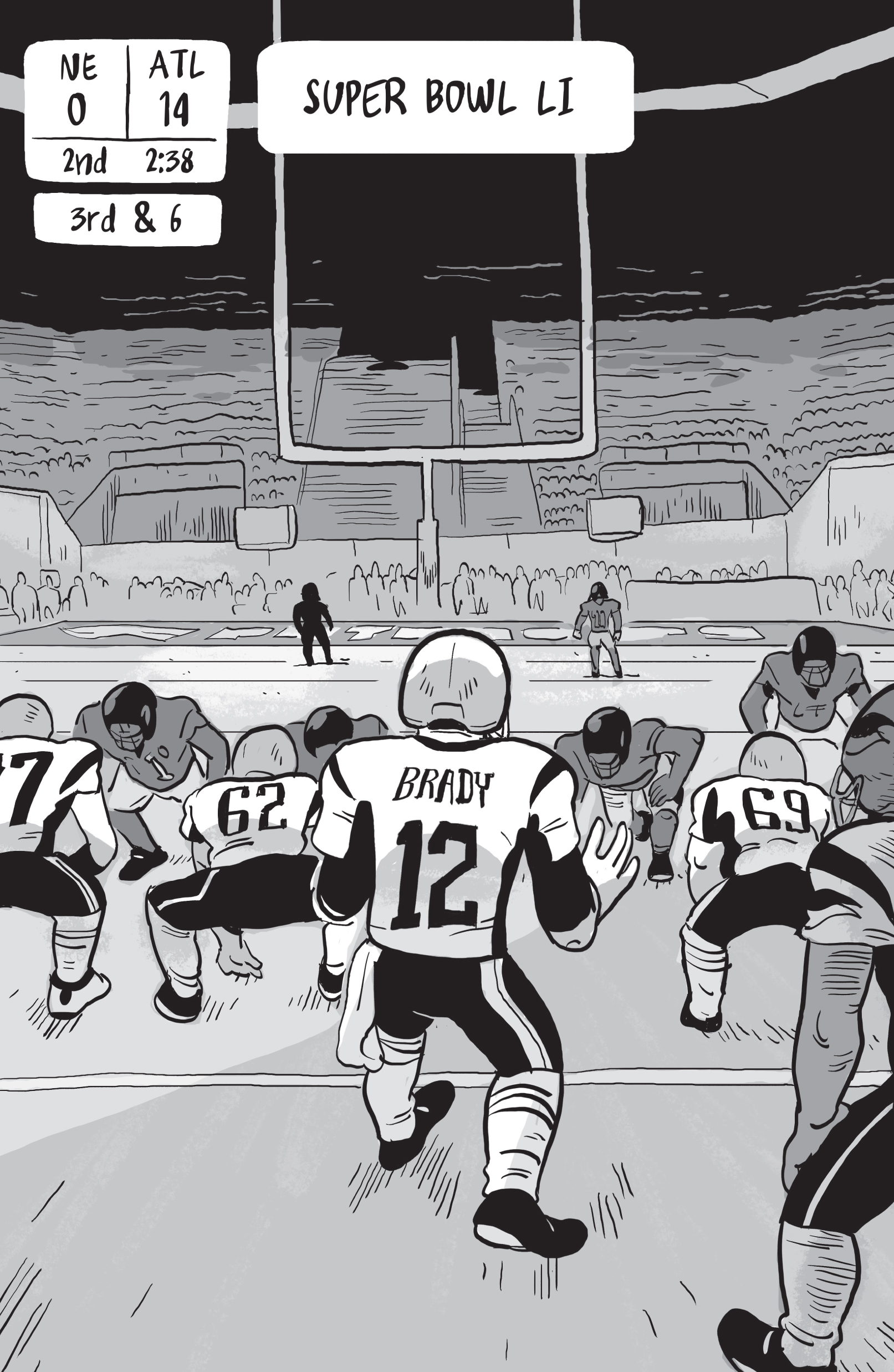
T OM BRADY WAS SPRAWLED OUT on his stomach, lying across the turf of NRG Stadium in Houston, Texas. He was looking up and watching as an Atlanta Falcons cornerback named Robert Alford sprinted through the open field toward a touchdown in the Super Bowl.
Just moments earlier, Brady tried to complete a pass to wide receiver Danny Amendola, when Alford stepped in front of him, intercepted the ball, raced to his right, avoided Bradys leaping tackle, and then took it all the way for a touchdown, a pick-six. After winding up in a heap on the field, Brady could do nothing but watch. High above, in the second quarter of the Super Bowl in February of 2017, the scoreboard read Atlanta 21, New England 0. No team had ever trailed by more than ten points and won the Big Game.
Tom Brady and the Patriots were in big, big trouble.
By the middle of the third quarter, it was even worse, Atlanta leading 283. All around the world people began turning off their televisions and giving up on New England. The Patriots had won four Super Bowls with Tom as their quarterback. They had executed dozens of miraculous comebacks across his long career, but this felt like too much even for the veteran QB.
Yet down on the Patriots sideline one person had most certainly not given up: Tom Brady. Tom began walking along the team bench shouting at his teammates to ignore the scoreboard and just do your job! They quickly cut the lead to 289. He told them to forget the dwindling time on the clock and worry about the next play. Soon it was 2812. He reminded them to trust the process and keep going. Suddenly it was 2820. Tom kept screaming come on, come on! Now it was Atlantas sideline that was nervous, scared they might blow the big lead in the Big Game.
By the time New England running back James White scored a touchdown and Tom passed it to Amendola for a two-point conversion, tying the score at 2828 with fifty-seven seconds remaining, he didnt have to say anything.
You just looked in his eyes, receiver Matthew Slater said.
If there ever was a football star who would not panic in the face of a 283 second-half deficit against a team as good as Atlanta, who wouldnt point fingers at failure but instead try to rally everyone together, who wouldnt be overcome by doubt, but instead recommit to the game plan, it would be Tom Brady. In one dramatic comeback, by far the largest in Super Bowl history, Tom relived his entire career. Hed never listened to anyone who counted him out.
Tom grew up in San Mateo, California, near San Francisco, the youngest child of four, with three very athletic sisters. He spent much of his youth trying to prove he could play with the older girls softball, soccer, basketball, whatever was being played at his familys home. He was an excellent quarterback at Junipero Serra High School, but when he arrived at the University of Michigan, he didnt see much playing time during his first three years on campus. He considered transferring back to a college in California, but he didnt like the idea of quitting. Instead he decided to stick it out and fight for the starting spot. He still didnt fully win the job until the second half of his senior year.
Given his limited college success, almost no one thought hed be much of a National Football League (NFL) player. New England drafted him in the sixth round, 199th overall. NFL teams drafted six other quarterbacks ahead of him. Tom wasnt sure hed even make any team, and he began thinking about a career outside of football. He barely played as a rookie, but he kept plugging away, improving his mechanics, studying game film, and preparing each week like he was the starter even though he mostly just stood on the sideline and held a clipboard.
In 2001, his second season, he only got in on the action because the starter was injured. Fans thought Tom would be a temporary fill-in. Tom saw things differently. Finally, here was his big chance.
He led New England to a victory in his first start, then they won four of five, and then finished the year with six consecutive victories. Each week he seemed to get a little better, a little more comfortable, a little more confident. The Patriots plowed through the playoffs and got into the Super Bowl, where they were a huge underdog to the defending champion Saint Louis Rams. Few believed in them, but Tom led a final-minute game-winning drive. The unheralded quarterback was the champion no one saw coming. He was just twenty-four years old.
By the time Super Bowl LI vs. Atlanta came along fifteen years later, Brady was considered perhaps the greatest quarterback ever. Hed been named Most Valuable Player (MVP) twice. His name was written all over the record books. Hed become a superstar. Yet he had never lost that initial fire, that drive, that sense that the world didnt believe in him. Sticking with the plan and never giving up hopeeven in the face of long oddsis how he got to that point. Its why he kept telling his teammates the game wasnt over, no matter the score.
You just have to keep going, Tom said.
His teammates listened intently because they had grown up watching Tom Brady become a legend. Wide receiver Chris Hogan was thirteen in February of 2002 when Brady and the Patriots beat Saint Louis for that first Super Bowl title. Hogan watched the game in his living room in New Jersey at his familys annual Super Bowl party. Tight end Matt Lengel was eleven at the time, watching with his grandfather in Kentucky. Special teamer Matthew Slater was with his brother in Southern California. Running back James White was ten in Florida. Receiver Malcolm Mitchell was nine in Georgia.
These are the kids Brady inspired to play football. These are the kids who grew up watching him do the impossible and then went out in their backyards and dreamed of being him. Now they could hardly believe they shared a locker room and a huddle with him, suddenly starring in their own boyhood dreams.
When Tom Brady says it, you listen, Mitchell said.
I believed it the entire time, Hogan said. He gave us the kick. He got everyone fired up.
The comeback was achieved one play at a time. One run. One pass. One block. One tackle. One field goal. Tom kept reminding his teammates that if everyone kept pulling in the same direction, then anything was possible. Its how Tom built his career. He isnt the biggest, the fastest, the strongest, or the most talented player in the world. He may be the most determined. He learned that while winning was great, the joy was in the journey and the daily challenges of practice and workouts when no one is watching and you are only competing against yourself. If he wasnt like that, he probably would have quit football at Michigan and never been heard of in the world of sports again.
There was another reason, a special reason, Tom was so intent on making his teammates keep playing hard. This was his seventh Super Bowl, but it was the first time in over a year that his mother, Galynn, had been able to come to a game and watch him play football. She had been stricken with cancer and had spent the previous months in her own daily battle against giving up, this one involving chemotherapy and recovery, doctors and hospitals.



